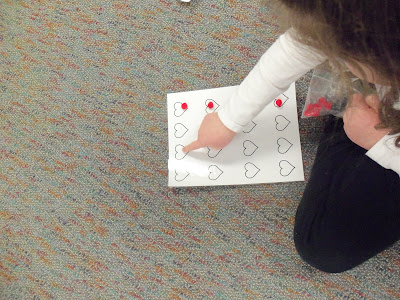Kindergarten students pretended to build a snowman as they learned a new song entitled Snowman Joe. The melody of this song is built on the major scale and allows students to feel the rise of each pitch as they slowly build their snowman. Students also feel the melody's decent as the snowman melts to the ground at the end of the song. Additionally, students began taking turns playing the steady beat on a drum during the song Punchinella. This song and its activity are currently being used to assess student development in the skill area of steady beat. Students also learned the song The Monkey Stomps His Feet. Students enjoyed stomping around the room to the steady beat and creating many other ways for the monkey to move. Lastly, students learned a series of movements for the song Jump, Jim Joe. Students worked with a partner in order to jump, shake their heads, nod their heads, and tap their toes.
First grade students worked hard to decode the rhythm of the song Pease Porridge this week! On Monday, students were given beat charts and asked to place pom-poms on all of the silent beats (the beats with quarter rests). On Friday, students were give the beat charts once more, but this time were instructed to find all of the beats with rests and eighth notes. Students used stick notation, a type of musical short hand, to write quarter notes, quarter rests, and eighth notes. Students then checked their work as a class using the interactive white board. I was so proud of the first graders this week; they have made such progress in rhythm reading and writing just since December! Additionally, students learned the song Hot Cross Buns and discussed its origins as a street cry. Students learned playing a fun elimination game which requires students to sit down if they are pointed to on a silent beat (rest).
 |
| This student is pointing to each heart beat while singing Pease Porridge. The pom pom indicates that there is a rest on that beat. |
 | |
| Students shared their answers on the interactive white board and each student checked their work. |
 |
| These students are writing the rhythm to Pease Porridge using stick notation, a type of musical short hand. |
 |
| These students have completely written the rhythm. |
 | |
| This student is proud to show off his excellent work! |
Second grade students reviewed new melodic note la by playing a game called poison pattern. In this game, one melodic pattern is designated as the poison pattern. Students are to echo sing all patterns except for the poison pattern. If the students are successful, then they earn one point for their class. If the students are not successful, if they sing the poison pattern, then the teacher gets one point! Mrs. Aaronson was happily defeated in this game! Students also reviewed half notes by playing xylophones along with the song Let Us Chase the Squirrel. Some students played half notes on the bass xylophones and bass bars while other students created the sound of the squirrel going up and down the tree by playing glissandos on glockenspiels. Lastly, students sang King's Land while playing its game. This song will be used next week to begin introducing melodic note do.
 |
| These students are playing the half note pulse on barred instruments to the song Let Us Chase the Squirrel. |
Fourth grade students completed their recorder unit this week. Although this is the end of the formal unit, students will have recorder days twice a month for the remainder of the school year. These recorder days will allow students to continue to develop their note reading skills and allow them to test for their next recorder karate belt. Students will be informed in advance of recorder days. To finish the recorder unit, students reviewed the notes of the treble clef staff as well as the fingerings for all known recorder notes. Students took a written assessment on the notes of the treble clef staff and the recorder fingerings. It has been a real joy to watch the students' progress in note reading over the last three months!
Fifth grade students reviewed the proper technique for shaping vowels "ah, eh, long e, long o, and oo". Students also reviewed Annie Kids songs N.Y.C. and Easy Street. In addition to working on trouble spots, students were challenged to sing these songs along with the accompaniment tracks. Students also began working on Annie Kids songs Hard-Knock Life and Never Fully Dressed without a Smile.

